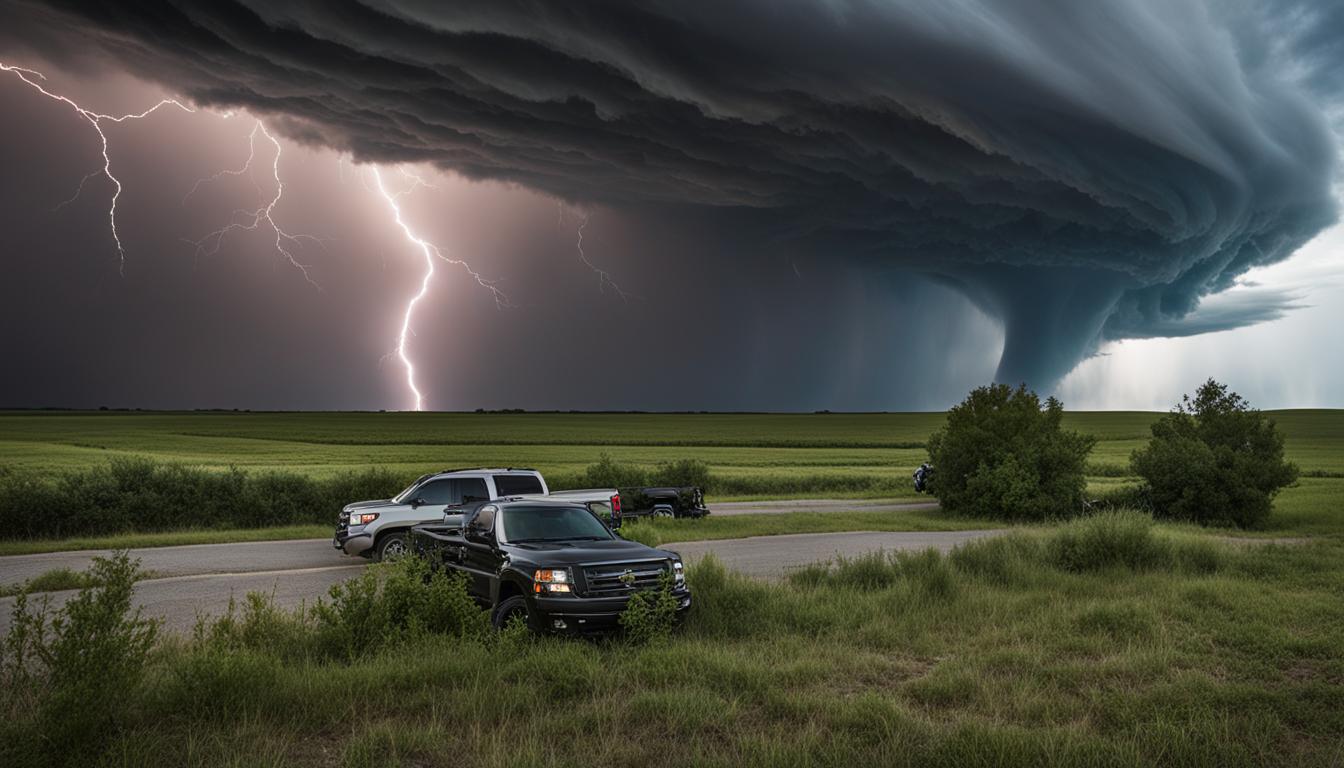When severe weather strikes, it is crucial to understand the difference between tornado watches and warnings to prioritize your safety and well-being. Tornado watches and warnings are both important alerts that provide valuable information about impending tornado activity. By understanding these alerts and taking the necessary precautions, you can effectively respond to tornado alerts and protect yourself and your loved ones.
Key Takeaways:
- Tornado watches are issued by the Storm Prediction Center and cover a large area where tornadoes are possible.
- Tornado warnings are issued by local forecast offices and indicate a tornado has been sighted or indicated by radar, with imminent danger to life and property.
- During a tornado warning, seek shelter immediately in an interior room on the lowest floor of a sturdy building.
- Review your emergency plans and ensure you have necessary supplies for tornado preparedness.
- Stay informed through severe weather alerts and have a tornado emergency plan in place.
Now that we’ve explored the difference between tornado watches and warnings, let’s delve into each alert in more detail to gain a comprehensive understanding of tornado preparedness and safety.
Understanding Tornado Watches
Tornado Watches are important alerts issued by the Storm Prediction Center to inform the public of the possibility of tornadoes occurring within a designated area. These watches cover a large geographic region, such as multiple counties or even states. It is crucial for individuals and communities to understand the significance of these watches and take the necessary steps to ensure their safety.
Why are Tornado Watches important?
Tornado Watches serve as a signal for people to review their emergency plans and be prepared to act quickly if a Tornado Warning is issued or if they suspect a tornado is approaching. These watches provide an opportunity for individuals to assess their current emergency preparedness and make any necessary adjustments.
How to stay informed during Tornado Watches:
- Monitor local news and weather updates
- Download weather apps or have alternative ways to receive severe weather alerts
- Stay connected with friends, family, and neighbors to share information and updates
Key points to remember:
- Take Tornado Watches seriously and review your emergency plans
- Prepare an emergency kit with essential supplies
- Stay informed through reliable sources of information
- Be ready to take immediate action if a Tornado Warning is issued or if tornado signs are present
Tornado Watches are an important part of staying safe during severe weather events. By understanding the significance of these watches and taking proactive measures, individuals can be better prepared to respond to tornado alerts. Remember to stay informed, review your emergency plans, and take appropriate action when necessary.
Understanding Tornado Warnings
Tornado Warnings are crucial alerts issued by local forecast offices to indicate the immediate danger posed by a tornado. These warnings are based on the sighting of a tornado or indications from weather radar. Unlike Tornado Watches, which cover a large area where tornadoes are possible, Tornado Warnings focus on a smaller geographic region that may be directly impacted by the tornado.
When a Tornado Warning is issued, it is essential to take immediate action to protect yourself and your loved ones. Seek shelter in an interior room on the lowest floor of a sturdy building, away from windows. If you are in a mobile home, vehicle, or outdoors, move to the closest substantial shelter and shield yourself from flying debris.
To ensure your safety during a Tornado Warning, it is important to follow tornado safety precautions. Avoid windows and seek shelter in a location with reinforced walls. The strong winds associated with tornadoes can cause significant damage, so taking cover in a sturdy structure is crucial. Stay updated on the latest information from local authorities and emergency management agencies.
| Tornado Warning Safety Precautions | Do’s | Don’ts |
|---|---|---|
| Seek shelter | – Move to an interior room on the lowest floor of a sturdy building – Take cover in a location with reinforced walls |
– Do not stay near windows or exterior walls – Avoid large open areas |
| Protect yourself from debris | – Shield yourself from flying debris – Use mattresses, blankets, or helmets to protect your head |
– Do not go outside to try to spot the tornado – Avoid seeking shelter in mobile homes or vehicles |
| Stay informed | – Listen to local authorities and emergency management agencies – Stay updated on weather information through radio, TV, or weather apps |
– Do not rely solely on outdoor sirens – Avoid spreading unverified information |
By understanding the importance of Tornado Warnings and taking the necessary precautions, you can help ensure the safety of yourself and your community during severe weather events. Remember to stay alert, follow the guidance of local authorities, and seek shelter in a secure location.
Preparedness and Safety Tips
Tornadoes are unpredictable and can cause significant damage and loss of life. It is crucial to be prepared and take necessary safety precautions to protect yourself and your loved ones. Here are some tips to help you stay safe during tornadoes:
- Review and discuss your emergency plans with your family. Ensure everyone knows the safest areas in your home to take shelter.
- Keep emergency kits stocked with essential supplies such as non-perishable food, water, cash, flashlights, batteries, and a first aid kit.
- Download weather apps or have alternative ways to receive severe weather alerts. Stay informed about any tornado watches or warnings in your area.
- Stay alert during severe weather and keep your cell phone charged. This will allow you to receive important updates and make emergency calls if needed.
- If you have special needs or pets, make sure to consider their requirements in your emergency plan. Have necessary supplies and accommodations ready for them.
- Clear out any large or loose materials in your yard that could become dangerous during strong winds. Secure outdoor furniture and objects.
- Identify a safe room in your home where you can take shelter during a tornado. It should be an interior room on the lowest floor and away from windows.
“Tornadoes are nature’s most violent storms. Being prepared and having a plan in place can make a significant difference in minimizing the impact of a tornado on your life and property.” – National Weather Service
By following these preparedness and safety tips, you can enhance your readiness for tornadoes and ensure the safety of yourself and your loved ones. It is essential to stay informed, have a plan, and take immediate action when tornado warnings are issued. Remember, your safety is paramount during severe weather events.

Conclusion
Understanding the difference between Tornado Watches and Warnings is crucial for tornado preparedness. Tornado Watches, issued by the Storm Prediction Center, indicate that tornadoes are possible within a large geographic area. It is a signal for individuals to review their emergency plans and be prepared to act quickly if a Tornado Warning is issued or if they suspect a tornado is approaching.
On the other hand, Tornado Warnings are issued by local forecast offices and signify that a tornado has been sighted or indicated by weather radar. Warnings cover a smaller area and mean there is imminent danger to life and property. During a Tornado Warning, it is important to seek shelter immediately in an interior room on the lowest floor of a sturdy building, away from windows.
By being informed and prepared, individuals can effectively respond to tornado alerts and prioritize their safety and the safety of their loved ones. Review and discuss emergency plans, ensure necessary supplies are stocked, and stay informed through severe weather alerts. By taking these precautions, you can mitigate the risks associated with tornadoes and increase your chances of staying safe during severe weather events.
FAQ
What is the difference between a Tornado Watch and a Tornado Warning?
A Tornado Watch is issued by the Storm Prediction Center and covers a large area where tornadoes are possible. It is a signal for people to be prepared and review their emergency plans. On the other hand, Tornado Warnings are issued by local forecast offices and indicate that a tornado has been sighted or indicated by weather radar. Warnings cover a smaller area and mean there is imminent danger to life and property.
What should I do during a Tornado Warning?
During a Tornado Warning, it is important to seek shelter immediately and move to an interior room on the lowest floor of a sturdy building. If you are in a mobile home, vehicle, or outdoors, move to the closest substantial shelter and protect yourself from flying debris. Avoid windows and take shelter in a location with reinforced walls.
How should I prepare for tornadoes?
To be prepared for tornadoes, review and discuss your emergency plans with your family. Ensure that you have necessary supplies and a safe room in your home. Keep emergency kits stocked with non-perishable food, cash, charging devices, flashlights, and batteries. Download weather apps or have alternative ways to receive severe weather alerts. Stay alert and keep your cell phone charged during severe weather. Consider the needs of individuals with special needs or pets in your emergency plan.
What precautions should I take for tornado safety?
It is important to follow tornado safety precautions, such as avoiding windows and taking shelter in a location with reinforced walls. Clear out any large or loose materials in your yard that could become dangerous during severe winds. Take steps to protect your property and have a plan in place for when severe weather strikes.
Why is it important to understand the difference between Tornado Watches and Warnings?
Understanding the difference between Tornado Watches and Warnings is crucial for staying safe during severe weather events. Tornado Watches indicate that tornadoes are possible in a large area, while Tornado Warnings mean that a tornado has been sighted or indicated by radar and there is imminent danger. By being prepared and informed, you can effectively respond to tornado alerts and prioritize the safety of yourself and your loved ones.
 Skip to main content
Skip to main content


